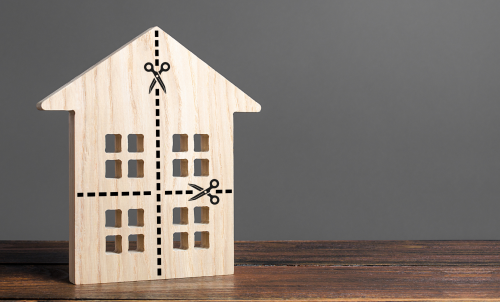.avif)
Unlocking Your Home's Value: Leveraging Your Home Equity
Your home is more than just four walls, windows, doors and a roof. It could potentially be a secret treasure trove of untapped potential. You could have the power to obtain things you thought were unattainable. Are you tired of wishing you could replace your living room furniture and the old kitchen? Has inflation caused you to overuse your credit cards and are you looking to consolidate your debts? Or do you want to take that dream holiday you have talked about for many years? Tapping into your home’s equity could be the answer.
As you gradually pay off your mortgage and your home's value increase, so does your home equity. This equity isn’t just numbers on paper. It’s real money you can tap into when you need it. You are essentially using your home as collateral to borrow money. There are two ways you can tap into your home's equity. You can apply and obtain a home equity loan, more commonly known as a second-charge mortgage, or a home equity line of credit (HELOC). Understanding these options can empower you to make more confident financial decisions.
Home Equity Loan or Second-Charge Mortgage Explained
Home equity loans, or second-charge mortgages, provide homeowners with a secure and flexible way to borrow money against the equity built up in their property. This equity represents the portion of the home that the homeowner truly owns. It will have increased as the first-charge mortgage has been partially paid down over the years and the property's value has probably also appreciated over time.
One of the main features of a home equity loan is that it provides borrowers with a lump sum of money upfront. This money can be used for various purposes, such as home improvements, debt consolidation or other financial needs. The lump sum is repaid over a fixed term with monthly payments which include principal and interest. This gives you the security of a structured repayment plan.
Understanding the eligibility criteria for a home equity loan is important. Second-charge mortgage lenders typically require borrowers to have a minimum amount of equity in the property, usually at least around 20% of the home's value, if not more. This usually means that borrowers must have paid off a significant portion of their first-charge mortgage before they can access a home equity loan. Also, lenders will consider the borrower's credit history, income and overall financial stability when determining eligibility. Knowing these guidelines can help you prepare and increase your chances of securing a home equity loan when needed.
Interest rates on home equity loans are typically fixed rates. This means the interest rate remains constant throughout the life of the loan. This gives borrowers predictability and stability in their monthly payments. This makes it easier to budget and plan for the future. Additionally, the terms of a home equity loan can vary depending on the lender and the borrower's individual circumstances. Most home equity loan terms are between 5 and 30 years. Some lenders may offer flexible repayment terms, which allows borrowers to choose the loan term length and the frequency of payments that best suit their needs.
Taking out a home equity loan has several advantages and disadvantages. First, it gives homeowners access to a significant amount of cash that can be used for various purposes. Whether funding home improvements, consolidating debt or covering unexpected expenses, a home equity loan can provide financial flexibility and peace of mind. The fixed interest rates and predictable monthly payments make it easier for borrowers to budget and plan for the future. However, there are also disadvantages to consider. Home equity loans use your property as collateral. This could be deemed risky because you could lose your home if you fail to make your payments. Furthermore, a home equity loan adds to your overall debt burden, and fees can be added if you pay it off early. Therefore, it's essential to carefully weigh the pros and cons before taking out a home equity loan. Understanding the terms and conditions of the agreement before proceeding is crucial.
HELOCs Explained
HELOCs, or Home Equity Lines of Credit, are much harder to find in the UK than traditional home equity loans or second-charge mortgages. They are much more common in the US. They have not yet gained as much popularity in the UK because the UK has traditionally favoured other forms of borrowing, such as personal loans or credit cards. However, with changing attitudes towards borrowing and increasing awareness of alternative financial products, HELOCs may see greater popularity in the UK in the future. If you are looking for a HELOC in the UK, you can try talking to your bank to determine if they offer this product or try reaching out to an independent lender.
What is a HELOC? A Home Equity Line of Credit (HELOC) is a type of loan that allows homeowners to borrow money against the equity they have built up in their property. Unlike a traditional home equity loan, a HELOC operates more like a revolving line of credit, similar to a credit card. Borrowers are approved for a certain credit limit and can borrow from it as needed. Some HELOCs may have a "draw period" during which borrowers can access funds, followed by a "repayment period" during which they must repay the outstanding balance. During the ‘draw period”, you can draw on your funds, repay them and then redraw. During the “repayment period”, you can no longer draw on the funds, and repayment must begin including interest.
There are several criteria that typically need to be met to qualify for a Home Equity Line of Credit (HELOC). Your property must have a minimum of at least 15% to 20% of home equity in it. Additionally, lenders will assess your income, credit history and overall financial stability to determine your eligibility. A stable income and a clear repayment history can increase your chances of approval. Also, because HELOCs are a revolving line of credit, borrowers may be subject to additional requirements. You might have to maintain a certain credit score or make regular payments on the outstanding balance. Finally, some lenders may have specific age requirements. It is always best to check with individual lenders to fully understand their eligibility criteria.
Interest rates on HELOCs are usually variable. This means that the interest rate and monthly payments will fluctuate during the life of the loan.
Home Equity Lines of Credit (HELOCs) have several advantages and disadvantages. On the plus side, HELOCs offer flexibility that allows homeowners to access funds as needed. This can be convenient for covering ongoing expenses or unexpected costs. Also, HELOCs typically have lower interest rates than credit cards or personal loans, and you only pay interest on the amount borrowed. However, there are also drawbacks to consider. One disadvantage is the risk of overspending. Homeowners may be tempted to borrow more than they can afford, which could lead to increased debt and financial strain. Additionally, because HELOCs use the home as collateral, there is a risk of triggering repossession if payments are not made on time. It is essential for borrowers to carefully weigh the pros and cons before taking out a HELOC.
Choosing the Right Option: HELOC vs Home Equity Loan
Choosing the right option for your specific financial well-being can seem overwhelming. Before making a decision, you should consider several factors.
- Your Needs: Are you looking for a one-time lump sum for a specific project or financial need (home equity loan or second-charge mortgage) or prefer having a safety net of funds you can dip into as needed (HELOC)?
- Interest Rates: Do you prefer the stability of a fixed rate (home equity loan or second-charge mortgage), or are you comfortable with the fluctuations of a variable rate (HELOC)?
- Repayment Flexibility: Are you comfortable with a set repayment schedule (home equity loan) or do you prefer the flexibility of paying back what you have used (HELOC)?
You should always discuss these points with your financial advisor to determine which option best suits your situation.
Alternatives to Consider
If neither a home equity loan nor a HELOC seems like the right fit for your needs, there are alternatives to consider.
- Personal Loans: If you have good credit, you might consider a personal loan. This option can give you the money you need without requiring you to put your house up for collateral.
- Credit Cards: Credit cards can be a quick fix for smaller expenses or emergencies. However, be careful, as they can have high interest rates that might cost you much more in the long run.
- Remortgage: You can remortgage your property and use the equity you have built up in your home to get some cash out. This can be a viable option for homeowners who want to access funds without taking out a separate loan
- Government Grants or Assistance: Depending on your circumstances, you might qualify for grants or assistance programs for specific needs, such as home improvements or energy efficiency upgrades.

FAQs:
Q. What is the difference between a home equity loan and a HELOC?
A. Home equity loans or second-charge mortgages usually offer a lump sum with a fixed interest rate, while HELOCs provide a line of credit with a variable rate, allowing you to borrow as needed.
Q. Which option is better for me, a home equity loan or a HELOC in the UK?
A. It depends on your needs, preferences, and financial situation. If you prefer a lump sum and stable payments, go for a home equity loan. If you want flexibility and access to funds over time, a HELOC might be the way to go.
Q. Can I use a home equity loan or HELOC for debt consolidation?
A. Consolidating high-interest debt with either option can be smart, potentially saving you money on interest payments.
Q. Are there alternatives to home equity loans and HELOCs in the UK?
A. Depending on your needs and eligibility, you can explore personal loans, credit cards, government grants or a remortgage with increased borrowing so that you can take some cash out.










